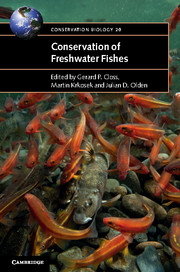Book contents
- Frontmatter
- Contents
- List of contributors
- Preface
- 1 Lost fishes, who is counting? The extent of the threat to freshwater fish biodiversity
- 2 Why are freshwater fish so threatened?
- 3 Climate change effects on freshwater fishes, conservation and management
- 4 Challenges and opportunities for fish conservation in dam-impacted waters
- 5 Chemical pollution
- 6 Multiple stressor effects on freshwater fish: a review and meta-analysis
- 7 Infectious disease and the conservation of freshwater fish
- 8 Non-indigenous fishes and their role in freshwater fish imperilment
- 9 Riparian management and the conservation of stream ecosystems and fishes
- 10 Fragmentation, connectivity and fish species persistence in freshwater ecosystems
- 11 Conservation of migratory fishes in freshwater ecosystems
- 12 Protecting apex predators
- 13 Artificial propagation of freshwater fishes: benefits and risks to recipient ecosystems from stocking, translocation and re-introduction
- 14 Freshwater conservation planning
- 15 Sustainable inland fisheries – perspectives from the recreational, commercial and subsistence sectors from around the globe
- 16 Understanding and conserving genetic diversity in a world dominated by alien introductions and native transfers: the case study of primary and peripheral freshwater fishes in southern Europe
- 17 Maintaining taxonomic skills; the decline of taxonomy – a threat to fish conservation
- 18 Synthesis – what is the future of freshwater fishes?
- Index
- References
2 - Why are freshwater fish so threatened?
Published online by Cambridge University Press: 05 December 2015
- Frontmatter
- Contents
- List of contributors
- Preface
- 1 Lost fishes, who is counting? The extent of the threat to freshwater fish biodiversity
- 2 Why are freshwater fish so threatened?
- 3 Climate change effects on freshwater fishes, conservation and management
- 4 Challenges and opportunities for fish conservation in dam-impacted waters
- 5 Chemical pollution
- 6 Multiple stressor effects on freshwater fish: a review and meta-analysis
- 7 Infectious disease and the conservation of freshwater fish
- 8 Non-indigenous fishes and their role in freshwater fish imperilment
- 9 Riparian management and the conservation of stream ecosystems and fishes
- 10 Fragmentation, connectivity and fish species persistence in freshwater ecosystems
- 11 Conservation of migratory fishes in freshwater ecosystems
- 12 Protecting apex predators
- 13 Artificial propagation of freshwater fishes: benefits and risks to recipient ecosystems from stocking, translocation and re-introduction
- 14 Freshwater conservation planning
- 15 Sustainable inland fisheries – perspectives from the recreational, commercial and subsistence sectors from around the globe
- 16 Understanding and conserving genetic diversity in a world dominated by alien introductions and native transfers: the case study of primary and peripheral freshwater fishes in southern Europe
- 17 Maintaining taxonomic skills; the decline of taxonomy – a threat to fish conservation
- 18 Synthesis – what is the future of freshwater fishes?
- Index
- References
Summary
INTRODUCTION
The huge diversity of freshwater fishes is concentrated into an area of habitat that covers only about 1% of the Earth's surface, and much of this limited area has already been extensively impacted and intensively managed to meet human needs (Dudgeon et al., 2006). As outlined in Chapter 1, the number and proportions of threatened species tend to rise wherever fish diversity coincides with dense human populations, intensive resource use and development pressure. Of particular concern is the substantial proportion of the global diversity of freshwater fishes concentrated within the Mekong and Amazon Basins and west-central Africa (Berra, 2001; Abell et al., 2008; Dudgeon, 2011; Chapter 1) with extensive exploitation of water resources planned to accelerate in future years (Dudgeon, 2011; Chapter 1). If current trends continue, and the social, political and economic models that have been used to develop industrialised regions of the world over the past two centuries prevail, then the future of a significant proportion of global diversity of freshwater fish species is clearly uncertain.
Understanding why so many freshwater fish species are threatened requires some understanding of their biology, diversity, distribution, biogeography and ecology, but also some appreciation of the social, economic and political forces that are causing humans to destroy the natural ecosystems upon which we all ultimately depend. To begin to understand the diversity of freshwater fishes, we first need to consider the processes that generated and continue to sustain the diversity of species we see today. Based on an understanding of how freshwater fish diversity is generated and sustained, we consider how vulnerable or resilient various freshwater fishes are to the range of anthropogenic impacts that impinge on freshwater ecosystems. Finally, we discuss how social, political and economic drivers influence human impacts on natural systems, and the changes needed to current models of development that can lead to a sustainable future for humans and the diverse range of freshwater fish species with which we share our planet. The aim of this chapter is to provide an overview of the key issues and threats driving the declines in freshwater fish diversity identified in Chapter 1; subsequent chapters provide more detail on the key issues and address our options for developing a sustainable future for freshwater fishes.
- Type
- Chapter
- Information
- Conservation of Freshwater Fishes , pp. 37 - 75Publisher: Cambridge University PressPrint publication year: 2015
References
- 15
- Cited by



